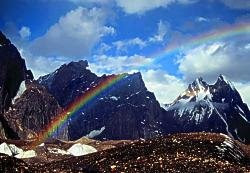
















Over long periods of time, mountains are created by tremendous forces in the earth with a steep top usually shaped up to a peak or ridge. Mountains occur more often in oceans than on land; some islands are the peaks of mountains coming out of the water. Mountains are formed by volcanism, erosion, and disturbances or uplift in the earth's crust. Most geologists believe that the majority of mountains are formed by geological forces heat and pressure producing changes under the earth's crust and movements in the earth's crust. They call this movement plate tectonics. This theory sees the crust of the earth divided into a number of vast rigid plates that move about at the rate of a few centimeters a year. The uplift is caused by the collision of plates below the earth's surface that triggers various geologic processes that produce this crustal uplift. Other processes are caused by horizontal compression that is the deformation of crustal strata which produces folds or wrinkles. The Himalayas, for example, were raised by the compression that accompanied collision of the Indian plate with the Eurasian plate. Another example is Europe's Alps and Jura mountains which were also formed by horizontal compression, generated in their case by collision with the African plate and the Eurasian plate.
Some ranges of low mountains are raised by nontectonic processes, and are caused by sculpturing effects of differential erosion. Erosion occurs when wind, rain and ice are present. Mountains are impacted by erosion through the combined action of wind, rain and ice changing the shapes of the mountains.
Volcanism causes mountains to form. Examples of mountains formed by periodically dangerous volcanic action are Mount Ranier and Mount Saint Helens in the United States, Mount Erebus in Antarctica, Mount Vesuvius in Italy, and Mount Fuji in Japan. Many of these volcanic mountains have summit craters that still emit steam and debris; others that no longer show signs of volcanic activity may only be dormant, not extinct. Shield volcanoes found in Mauna Loa and Mauna Kea in Hawaii are less spectacular even when quite high.



















No comments:
Post a Comment